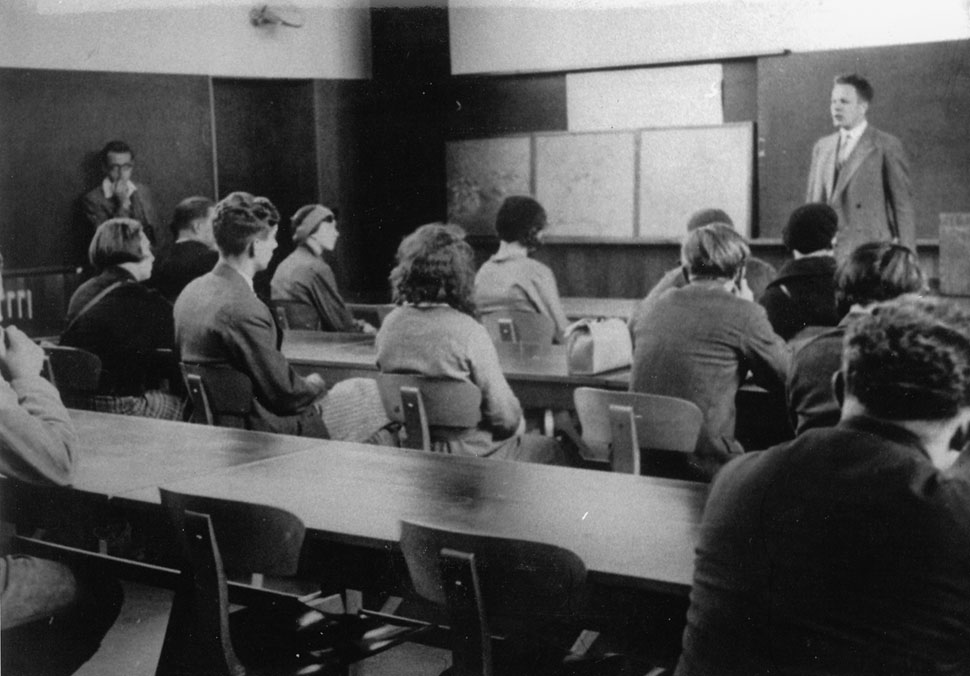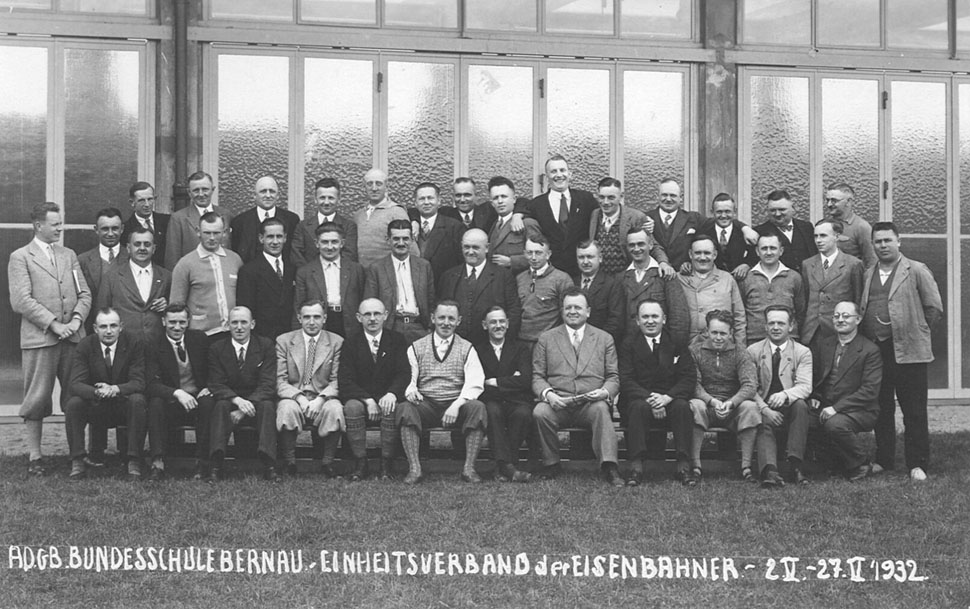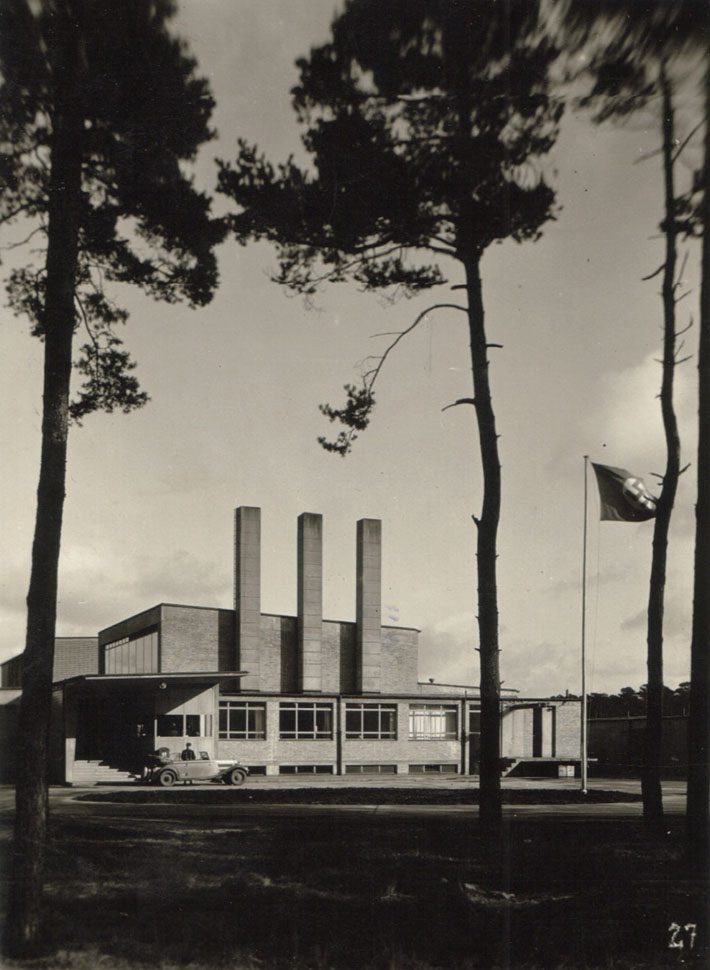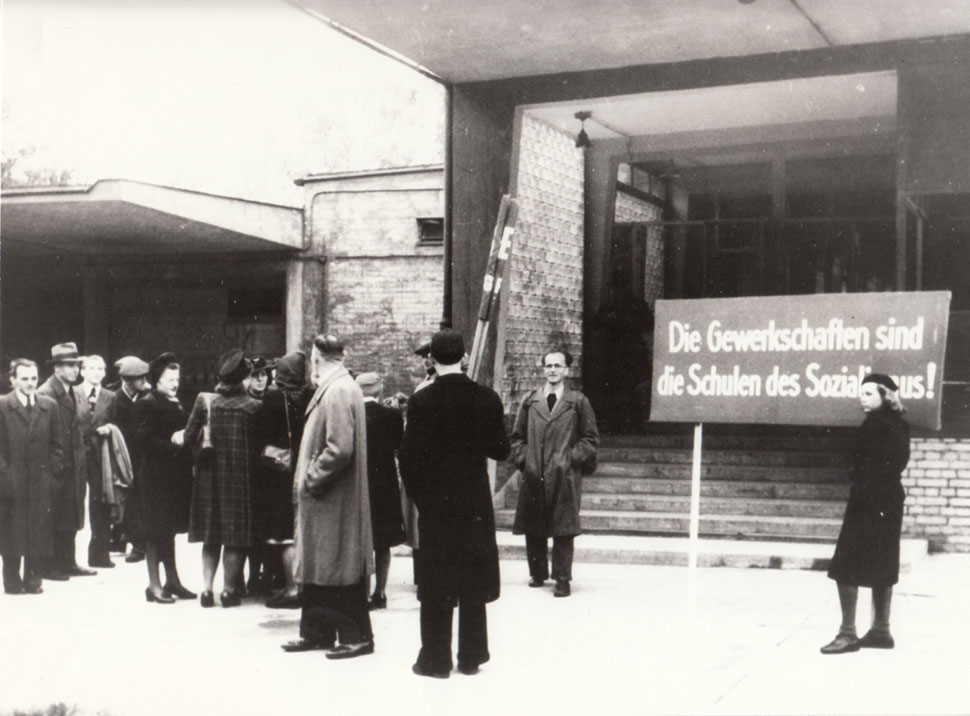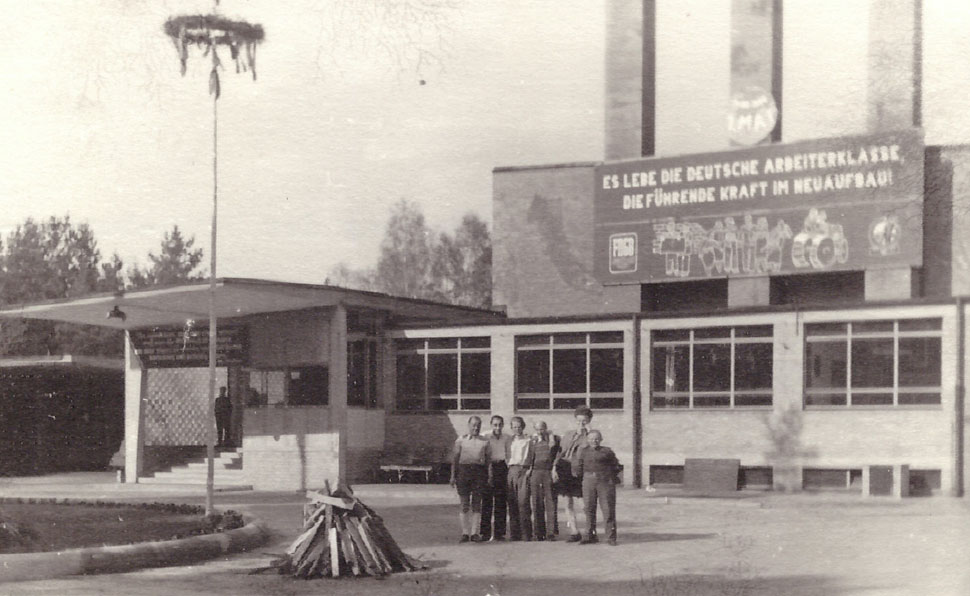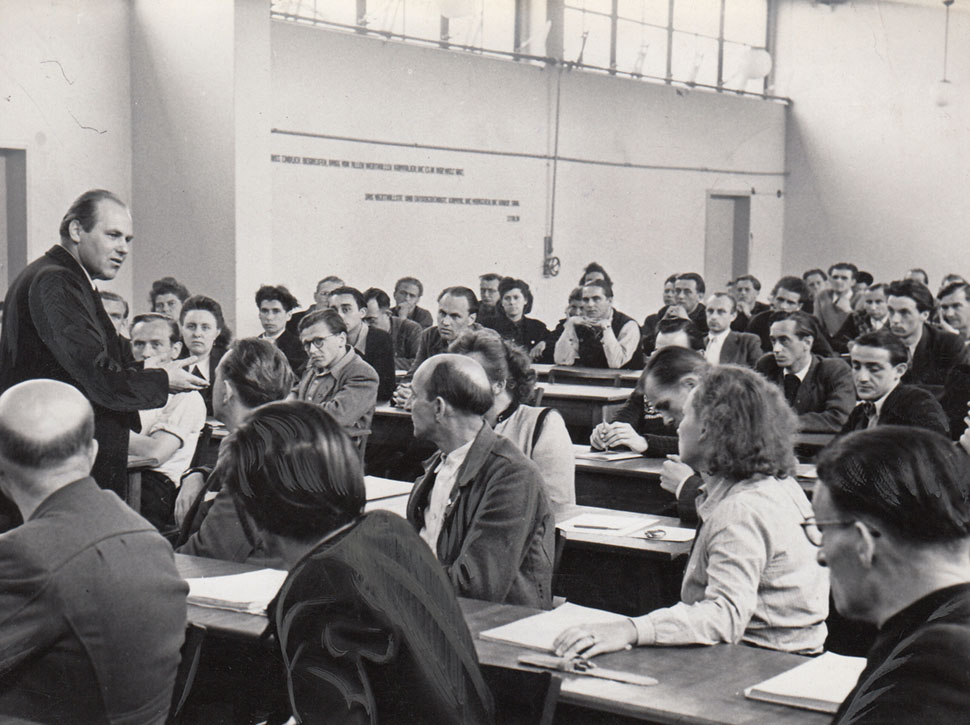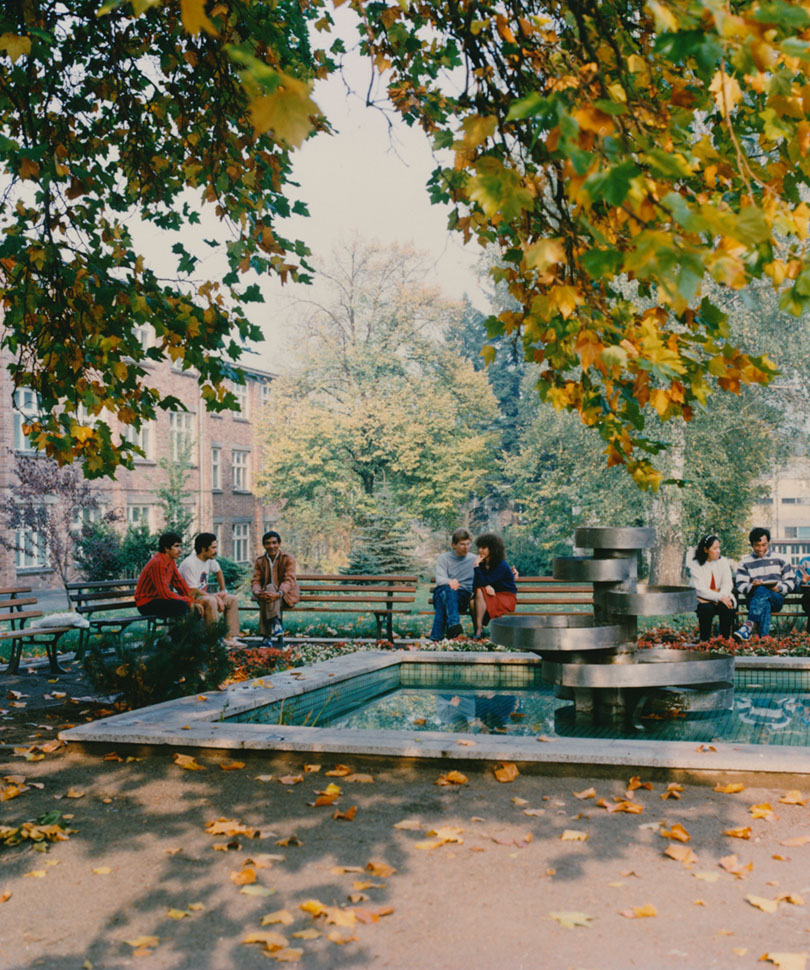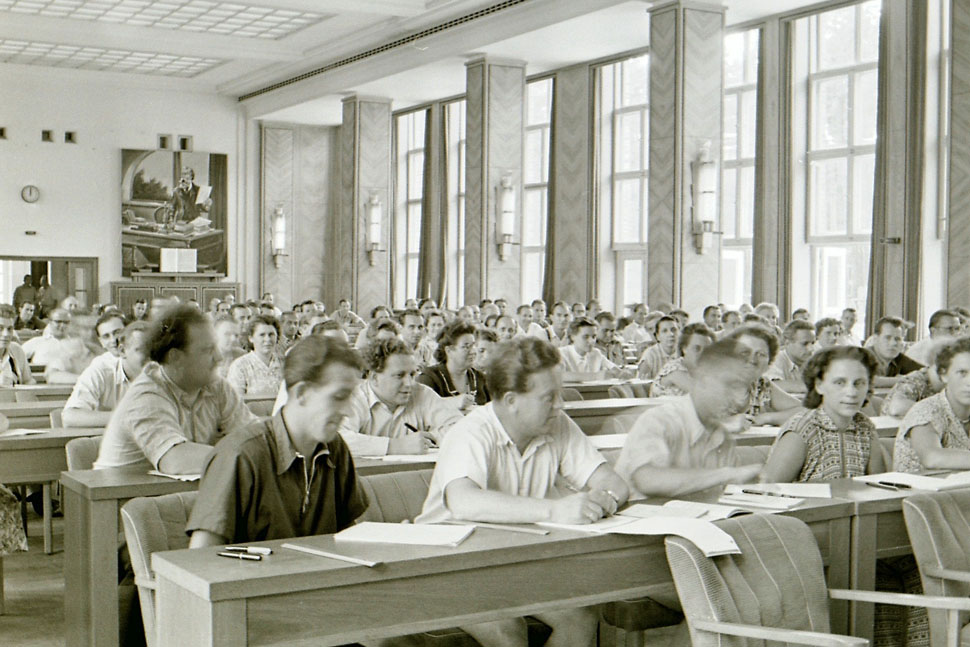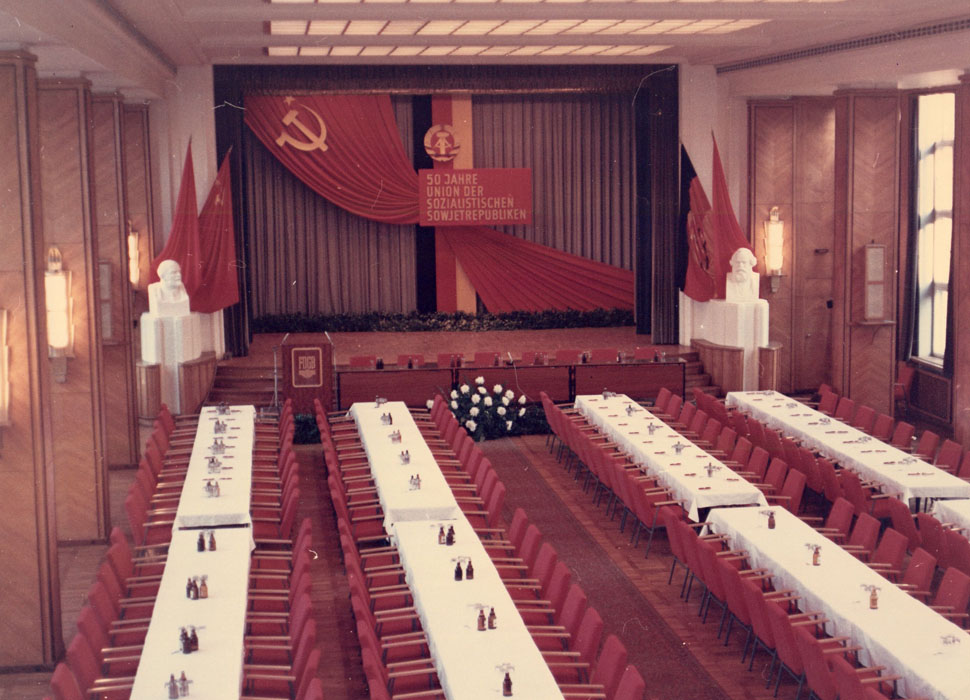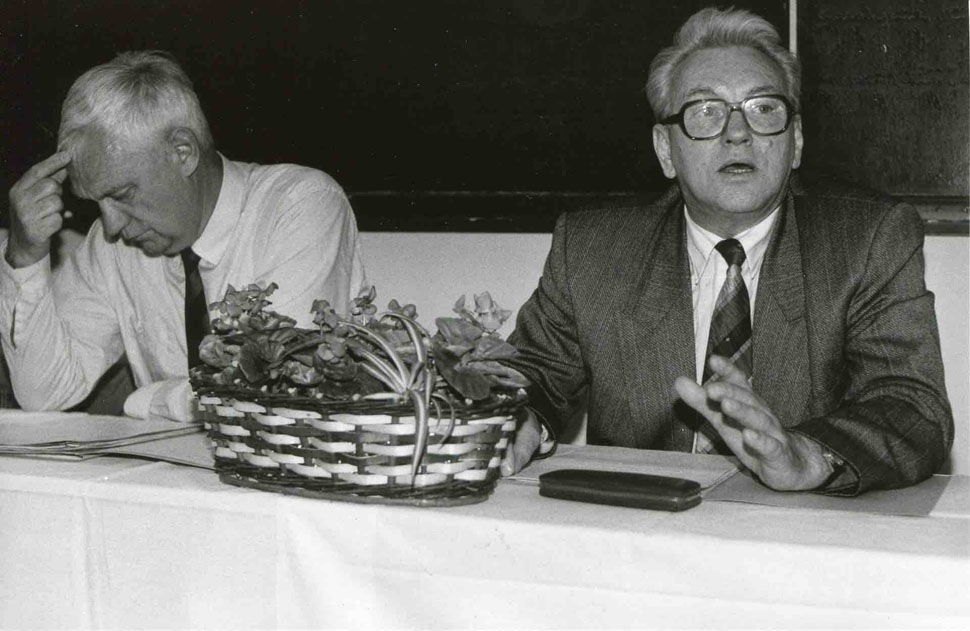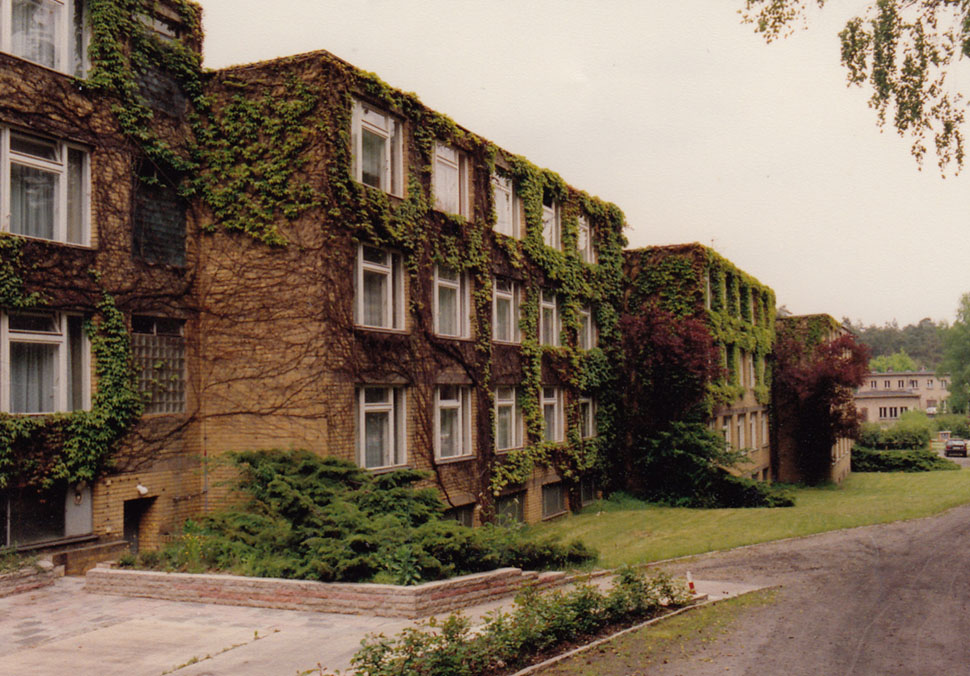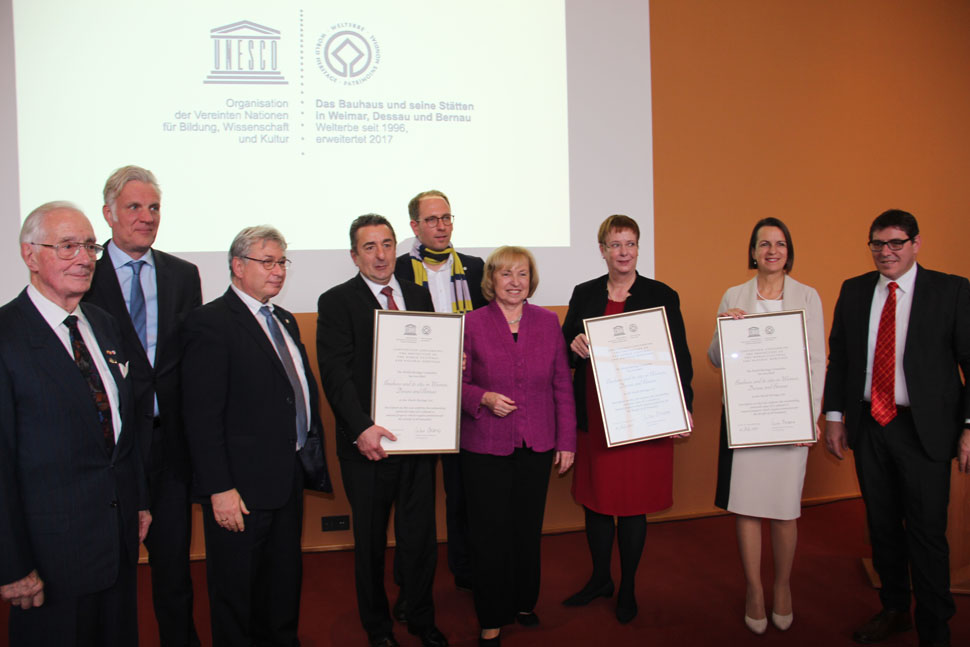ADGB Trade Union School (1927–1933)
After the opening of the ADGB Trade Union School on 4 May 1930, the first course offered was for members of the General Association of Employees of Public Companies and of Passenger and Goods Transportation as well as members of the German Textile Workers' Association.
The courses advertised by the Allgemeine Deutsche Gewerkschaftsbund (ADGB, German Confederation of Trade Unions) were organized and financed by industrial unions and trade unions which were members of the ADGB and which were involved in the construction of the school. The cooperation between the association's executive committees, ADGB and the school was an essential basis of the work.
The aim of the training was to educate mainly volunteer functionaries who were able to carry out effective trade union work under the political, economic and social conditions which deteriorated enormously towards the end of the Weimar Republic. As emphasized in the opening speech, the objective was to enable trade unionists to correctly assess economic processes and to promote the cooperation of the trade unions united in the ADGB as well as their international activities. Therefore, classes focussed especially on problems that affected more than one union.
Teaching
Two- and four-week introductory courses, advanced and specialized courses were held at the Trade Union School. There were also special courses for youth leaders, youth secretaries and women as well as information events for trade unionists from abroad. In the period from May 1930 to April 1933 about 5000 trade unionists took part in the courses.
The training focussed on business and economic issues, problems of social policy, especially collective bargaining and arbitration, social security and health and safety, questions of labour law and an introduction to the history of the association.
Classes were held by the permanently employed lecturers Dr. Hermann Seelbach (head of the school), Dr. Franz Große (economic policy) and Dr. Curt Gusko (labour law) as well as by guest lecturers. Almost every day interested people from Germany and abroad visited the school, which was one of the most modern educational institutions of its time.
Leisure
After classes there usually were evening events three times a week. The sports field, gymnasium and swimming pool offered a variety of opportunities for physical activity. The library was stocked not only with specialist literature, but also with a wide range of fiction. The daily press was available in the leisure rooms. Board games and other games invited to spend time together in the wintergarden. The sound film facility in the lecture hall offered a rich selection of entertainment films and films about the daily life issues of the trade union associations. Readings and recitals as well as lectures on current topics completed the leisure activities.
National Socialist "Führerschule" (1933–1945)
With the seizure of power by the National Socialists in Germany on 30 January 1933, the systematic destruction of all organizations of the labour movement and their institutions began. This included the largest organization of workers and employees, the trade union.
After two raids, on 6 and 9 May, as part of a large-scale action to destroy trade unions throughout Germany, the ADGB Trae Union School was also occupied. Around 10 a.m., 50 members of the SA Sturmbann IV/208 from Berlin gain accessed to the school and instructed the students to leave the facility by 3 p.m. Teaching and administrative staff were ordered to withdraw to their private rooms. The head of school was deposed. Richard Timm, the former youth secretary of the ADGB’s woodworkers' association, who was responsible for the administrative work at the school, was forced to hand over the school to SA and sign a handover certificate.
Dr. K. O. Schreiter, functionary of the Hamburg National Socialist Workers' Organisation (NSBO) and R. Mayrhofer, Gauleiter of the National Socialist German Workers' Party (NSDAP) in Lower Bavaria, subsequently took over the management of the school and set up the "Reichsführer School of the NSDAP and the German Labour Front" (DAF), dedicated by Adolf Hitler on 16 June 1933.
"Reichsführer School"
Henceforth, top functionaries of the NSDAP, the DAF and the NSBO were trained in the Reichsführer School, declared as the "University of National Socialism”. The best graduates of the NSDAP's regional and state leadership schools were educated here to become "leaders of strong character". The first course was reserved exclusively for the officials of the NSDAP and the DAF as well as for members of the state and district parliaments. The lessons were conducted in "soldierly form".
Teaching contend were German history, the origin and development of the National Socialist movement, the world view of liberalism and Marxism, racial issues, genetic theory, German law, fascism, sports, etc. In addition to permanently employed teachers, leading representatives of the Nazi regime such as Joseph Goebbels, Alfred Rosenberg, Robert Ley, etc. held lectures. For the first year of training (June 1933—June 1934), 650 participants take part in nine courses (3—4 weeks). In addition to the regular lessons, military exercises, comradeship evenings and excursions took place in the free time. A shooting range and military sports facilities were built. The swimming pool was provided with a concrete floor.
SD School Bernau near Berlin
On 6 June 1936 the Reichsführer School of the NSDAP was taken over by the Reichsführung SS (Reich Security Main Office) and renamed "SD School Bernau near Berlin". Due to fencing courses, which were held at the suggestion of SD head Reinhard Heydrich, it also became known as "SS Fencing School". However, its primary purpose was the training of SS, SD and Gestapo members. Its director was SS-Sturmbannführer Karl Hoffmann. Until early 1939 plans existedto change the "Bolshevik Bauhaus style", which had been vilified by the Nazis, by means of extensions and conversions. Due to the war preparations, they were, however, never carried out.
From mid-1939 the school served the immediate preparation for the Second World War. SD executives who were to take over the administration of the occupied territories after the conquest of Poland were trained here. They were prepared for this mission according to special training programs.
In August 1939 and under strictest secrecy, the briefing of those SS members took place in the SD school who, under the camouflage name "Unternehmen Tannenberg", wearing Polish uniforms, raided the German Reich Radio Station in Gleiwitz and the Hochlinden customs station on 31 August in order to create a pretext for starting World War II.
Attempts by large companies to use the facility to house foreign forced laborers from 1940 onwards were rejected by the SS. For its continued use as a training facility for the SS, the school was provided with camouflage painting at the beginning of the war.
"Theodor Leipart" Trade Union School (1947–1951)
Since April 1945, the school complex, some of which was badly damaged, had served as a military hospital for the Red Army. At the beginning of 1946, the Free German Trade Union Federation (FDGB), founded in Berlin in June 1945, negotiated with the Soviet Military Administration (SMAD) on the return of the school to the trade unions. This was based on the premise that the former ADGB Trade Union School should now be used as a central educational institution for functionaries of the new free trade unions from all four occupation zones. Due to extensive repair work, the buildings erected by Hannes Meyer and Hans Wittwer could not be returned to their original purpose until 2 May 1947.
Nine main courses and 85 special courses were held at the "Theodor Leipart" Trade Union School of the FDGB between 1947 and 1949, attended by 3094 trade unionists from the Soviet occupation zone. Participants were taught basic knowledge of the history of the German workers' and trade union movement, worker participation and the tasks of works councils, collective bargaining and social welfare, labour law, youth and organisational issues, as well as literature and art. The training was based on Marxist principles and was oriented towards the requirements of anti-fascist democratic construction.
The lessons, which were given by full-time teachers of the FDGB, were supplemented by classes held by functionaries of the FDGB (Hans Jendretzky, Bernhard Göring and Ernst Lemmer), the industrial unions (IG) and trade unions as well as representatives of the parties and the state governments. The first courses were organised by Emil Kortmann.
Extensions
The position of the trade unions in the GDR, which was founded on 7 October 1949, and especially their role in the companies, made it necessary to provide more and more functionaries with comprehensive trade union policy knowledge.
Hence, on 14 May 1950 the foundation stone was laid for a new school, boarding school, administration and residential buildings, which were completed at the end of 1951. The project was designed by the architect Georg Waterstradt, who endeavoured to follow the intentions of Hannes Meyer and Hans Wittwer. The government of the GDR supported the building project with extensive investments. These buildings, too, are today protected as historical monuments and evidence of a short, progressive construction phase in the GDR. This also includes the connecting passage between the building complexes, which documents a break with the Bauhaus tradition. Together with the disfiguring conversions of the entrance area, it illustrates the abandonment of the ideas of modernism.
From Trade Union School to Trade Union College
With the SED's decision on the first five-year plan in 1950, the trade unions were fully involved in the forced development towards socialism, which led to an ever greater dissociation from reformist views. The third FDGB Congress (30.8.—3.9.1950) instructed the Federal Executive Committee to create the conditions for the development of the FDGB's Trade Union School into a college with an extension of the course duration to one or two years, in which senior officials of the FDGB and industrial trade unions were to be trained. Guest lecturers from the Soviet Union participated in the training, giving lectures on the history of the CPSU, on philosophy and political economy.
During the transition to higher education in 1950/51, chairs were established, new teaching content was developed, a teaching and teaching materials department was set up, and the library was provided with a reading room. At the same time, service areas were set up and the gymnasium, the swimming pool and the sports field were re-equipped for sports activities. In 1951 the sports association Wissenschaft (science) was founded.
Parallel to the main courses at the Trade Union School, classes were set up in Bernau and Dresden for the education of teachers in trade union training work. In January 1952, the FDGB's "Theodor Leipart" Trade Union School was renamed the Trade Union College and was given the name of the communist trade unionist "Fritz Heckert".
"Fritz Heckert" Trade Union College (1952–1989)
After the opening of the "Fritz Heckert" Trade Union College, one one-year and three two-year courses were held from 1952 to 1955, in which about 500 trade unionists participated. In 1956, the school was officially elevated to the rank of a College and was granted the right to award diplomas. Due to this, the courses were extended to three years, a distance learning course was introduced in 1957 and a special course for women was established in 1961.
The curriculum covered the following areas: History of the German and international labour movement, philosophy, political economy, labour economics, social policy, labour law, culture and educational work as well as gaining experience in organisational work. Student days, public diploma defences and colloquia complemented and expanded the training programme. The school organized scientific seminars and conferences on various topics of trade union representation. In doing so, it was guided by the priorities set by the leadership of the SED, namely ideological influence and a mostly uncritical adoption of Soviet experience.
The teaching staff was enlarged by graduates of universities and colleges and additionally qualified by external studies. From 1949 to 1960 the school was under the direction of Prof. Dr. Hermann Duncker. In the following two decades, the school developped into an internationally recognized education and research centre.
At the end of the fifties and the beginning of the sixties, further boarding school, institute and residential buildings were built, the design of which corresponded to the architectural ideas prevailing in the GDR at the time. Also, the first standardized buildings were erected as part of the industrial building production.
Education of foreigners
As part of the international work of the FDGB, the college begins to train trade unionists from African, Asian, and later Latin American and some Western European countries in 1959. This task was performed by a special teaching department in which thirty teachers, seven interpreters and technical staff were employed at the end of the eighties.
The foreign colleagues were taught basic knowledge of trade union co-determination, political economy, the history of the trade union and national liberation movement, the struggle against imperialism and neo-colonialism, labour law, social policy, organisation building as well as experiences of the FDGB in the anti-fascist democratic upheaval of the first post-war years (1945—1948).
Information on the work of the trade unions in the GDR and excursions completed the training programme. From 1959 to 1989, around 4400 trade unionists from 93 countries took part in short and long-term courses. The courses were financed exclusively by solidarity contributions from trade unionists in the GDR. In 1984, approximately 6 million marks were made available for this purpose. Events were held at the college with officials of the international trade union movement and representatives of trade union educational institutions from other countries.
The university in the late 1980s
The development of new technologies as well as computer technology and the resulting demands on trade union work were incorporated into the training programme. In a specially equipped computer cabinet, basic knowledge for the use and application of personal computers was taught. Special research groups were created, in which students participated as well. In 1986 the university was granted the right to award doctorates. The training and research continued to run within the ideologically defined framework in the eighties. Efforts at critical analysis and new concepts remained marginal phenomena. They did not reach the public until early November 1989 with the document "For a Turnaround in Trade Unionism".
With the resumption of the Bauhaus tradition in the GDR at the beginning of the 1980s, projects for the preservation of the Meyer/Wittwer building and for a meaningful classification of necessary extensions were developed and discussed at the Trade Union College. However, they were not taken into consideration when a boarding school, a canteen, a boiler house, a residential complex and a children's facility were built from 1980 onwards in the typical standardized block construction.
Since its reopening in 1947, about 15,000 trade unionists had been trained in Bernau. On 30 September 1990, the Trade Union College was closed in the course of the dissolution of the FDGB. 195 teachers and 345 employees and workers were dismissed.
On the 60th anniversary of the opening of the Trade Union School, an event was held on 4 May 1990. Friends of the Bauhaus from the German Democratic Republic, the Federal Republic of Germany and from Switzerland founded the association "baudenkmal bundesschule bernau e. V.”
Uncertainty and vacancy (1990–2006)
After the closure of the Trade Union College in September 1990, the preservation and use of the historically protected buildings and outdoor facilities remained uncertain for a long period of time. The building complex was first managed by the Asset Management Company (VVG) of the Free German Trade Unions and leased to various interested users (including the Federal Insurance Office for Employees and the Bernau Learning and Community Center).
In August 1991, the privatization agency Treuhandanstalt leased the property to the State of Brandenburg to establish a School of Public Administration (FH). Classes began on January 1, 1992. The first renovation and partial reconstruction work on the roof in front of the gym and on a teacher’s residence was financed by funds raised by the bbb Association.
In December 1993, the State of Brandenburg and the City of Bernau bei Berlin signed a sixty-year heritable building right contract for the former FDGB Trade Union School property. But in 1996, the state government took over the complex once again with the intention of transferring it to the FH, which finally took place on August 31, 1998.
Vacancy and new hopes
The ensuing vacancy of the complex led to significant structural damages. The efforts of the state government to find a valid and functional reuse for the core of the historically protected section, the Meyer-Wittwer-Bau, were finally met with success in September 2000.
With its signing of a heritable building right sub-lease contract with the State of Brandenburg, the Handwerkskammer Berlin (HWK, Berlin Chamber of Crafts) became the new proprietors of the main section of the historically protected structure (the Meyer-Wittwer-Bau), which did not include the teacher housings and outdoor facilities.
Renovation of an Icon
The Berlin Chamber of Craft's legal rights were conferred in September 2001. As such, all the conditions were set for the landmark’s proper and professional renovation and future use. In January 2001, a European-wide call for submissions was issued for the redevelopment project, to which 102 architects and design offices responded.
In July 2001, HWK’s executive committee awarded the contract for the general planning of the renovation and partial reconstruction of the Meyer-Wittwer-Bau and senior project management to the Berlin offices of BRENNE. ARCHITEKTEN.
The planning and preparatory work began in September 2001 and the first phase of construction was started in February 2003. In early 2005, the work in the foyer and the dormitories was completed. The second phase lasted until late 2007.
Today the school building has been almost completely restored to its original state. The entrance area of the main building section from the 1950s was retained, thus preserving both historical levels — modernism and early GDR architecture.
UNESCO World Heritage and outlook (2007–2023)
In August 2009, after the State of Brandenburg released funding, BRENNE ARCHITEKTEN began renovation and reconstruction work on the teacher housings of the Trade Union School monument. At the end of 2010, the first occupants moved into the renovated apartments. After the Berlin Chamber of Crafts, the Michels Education Forum for Healthcare Professions Brandenburg uses the Meyer-Wittwer-Bau today as a residential school in Bernau-Waldfrieden.
Designation as a World Heritage Site
In August 2012, the States of Brandenburg, Saxony-Anhalt and Thuringia submitted a joint proposal for adding the former ADGB Trade Union School and the Dessau-Törten Estate to the Bauhaus sites of Weimar and Dessau, which were already included on the UNESCO World Heritage List in 1996. In July 2017, the Trade Union School was included in the UNESCO World Heritage List. On 7 October 2015 the association baudenkmal bundesschule bernau e. V. received the Brandenburg Building Culture Prize/Initiative Prize. In 2016, the revitalisation of the outdoor facilities at Bauhaus Denkmal Bernau began, which has now been completed. This includes the green strip of the access road Fritz-Heckert-Straße, the entrance area to the Hannes-Meyer-Campus, the entire campus, the reconstruction of the pergola in the inner courtyard and the area around the pond. Vacant buildings on the campus that were not listed as historical monuments were demolished. A new visitor parking lot has been created on part of the site. In 2022 a Visitor Centre opened on the Hannes-Meyer-Campus. Here, our visitors are able to find out about the Bauhaus World Heritage Bernau, about the UNESCO World Heritage Site "The Bauhaus and its Sites in Weimar, Dessau and Bernau" and about the UNESCO. At the Teachers' House 9 the asscoiation bbb now shows changing exhibitions.

